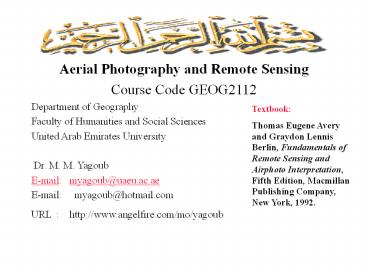Aerial Photography and Remote Sensing - PowerPoint PPT Presentation
Title:
Aerial Photography and Remote Sensing
Description:
Course Code GEOG2112 Department of Geography Faculty of Humanities and Social Sciences United Arab Emirates University Dr. M. M. Yagoub E-mail: myagoub_at_uaeu.ac.ae – PowerPoint PPT presentation
Number of Views:2401
Avg rating:3.0/5.0
Title: Aerial Photography and Remote Sensing
1
- Aerial Photography and Remote Sensing
- Course Code GEOG2112
- Department of Geography
- Faculty of Humanities and Social Sciences
- United Arab Emirates University
- Dr. M. M. Yagoub
- E-mail myagoub_at_uaeu.ac.ae
- E-mail myagoub_at_hotmail.com
- URL http//www.angelfire.com/mo/yagoub
Textbook Thomas Eugene Avery and Graydon Lennis
Berlin, Fundamentals of Remote Sensing and
Airphoto Interpretation, Fifth Edition, Macmillan
Publishing Company, New York, 1992.
2
Overview
- Course overview
- What is remote sensing?
- History of remote sensing
- Remote sensing organizations / web sites
- Remote sensing literature
- Remote sensing basic processes
- Advantages of remote sensing
- Remote sensing applications
3
Course overview
- The objective of this course is to introduce
students to - The principles of Aerial photography
- The principles of Remote Sensing
- Visual Image Interpretation
- Digital Image classification
- Usage of aerial photography and satellite
imagery in Environmental Applications
4
Assessment
- Final Exam 40
- Mid Term Exam 25
- Quiz 10
- Course work 20
- Computer presentation 5
- Total 100
5
What is remote sensing?
- The International Society for Photogrammetry and
Remote Sensing (ISPRS) defined Remote Sensing
(RS) as - The art, science, and technology of obtaining
reliable information about physical objects and
the environment, through the process of
recording, measuring, and interpreting imagery
and digital representation of energy patterns
derived from non contact sensor system " . This
definition considered photogrammetry as sub-field
of remote sensing - via cameras recording on film, which may then be
scanned (aerial photos) - via sensors, which directly output digital data
(satellite imagery)
6
Remote sensing
Satellite
Aero-plane
7
History of remote sensing
- 1783 The Marquis dArlandes and Pilatre made a
voyage near Paris using a balloon. - Photography using balloon, pigeon
- 1860 Aerial photos in Russia and the USA
- 1914-19 The first World War and the second
World War (1939-45) had seen tremendous
development in photography - 1927 Robert Goddard launched the first
liquid-fueled rocket. - 1955 Work began on the Baikonur launch site in
central Asia. - 1957 Sputnik 1 launched from Baikonur (first
satellite) - 1961 Yuri Gagarin launched in the Vostok 1
capsule, becoming the first human in space. - 1969 Neil Armstrong and Buzz Aldrin became the
first humans to walk on the Moon. - 1971 The first Space Station in history, the
Russian Salyut 1 - 1972 (US Landsat1) the concept of imaging from
satellites is introduced - 1986 France launched the first stereo-image
satellite (SPOT1) - 1992 The space year (the maturity of remote
sensing - 20 years of operation) - 1995 The Shuttle-Mir Program (1st phase of the
International Space Station (ISS). - 2000 The first 3 astronauts (2 Russian and one
American) start to live in the ISS
8
Remote Sensing Organizations
- ISPRS- International Society for Photogrammetry
and Remote Sensing - IGARSS- International Geosciences And Remote
Sensing Symposium - NASA -National Aeronautic and Space
Administration (USA) - ESA- European Space Agency (Europe)
- NASDA- National Space Development Agency (Japan)
- CNES- Centre National d'Etudes Spatiales (France
) - DARA- German Space Agency
- CSA - Canadian Space Agency
- NRSA- National Remote Sensing Agency of India
9
Remote sensing web sites
- http//ftp.geog.ucl.ac.be/patrick/geogr/Eteledete
c.html - remote sensing index - http// www.esrin.esa.it - Eurpopean Space
Agency - http//geo.arc.nasa.gov - NASA program
http//www.spot.com - French satellite SPOT - http//www.nasda.go.jp/ - Japan space agency
- http//www.rka.ru./ Russian Space Agency (RSA)
- http//www.coresw.com - Russian imagery source
- http//www.space.gc.ca/ Canadian Space Agency
(CSA) - http//www.ccrs.nrcan.gc.ca/ccrs/ -Canada Center
for Remote Sensing - http//www.inpe.br/ National Institute for Space
Research (Brazil) - http//www.asprs.org - American
Society - http//www.man.ac.uk - Manshester
Univ. - http//www.idrisi.clarku.edu - Idrisi site
- http//www.amazon.com - Bookstore
- http//www.brevard.cc.fl.us/BTR_Labs/bober/martin/
rs/overview.htm -
Dr. Martin McClinton, (.ppt) format (V. Good)
10
Remote sensing literature-Journal/Conferences
- Photogrammetric Engineering and Remote sensing
(PE RS) - Photogrammetric Record
- International Journal of Remote Sensing
- ISPRS Journal of Photogrammetry and Remote
Sensing - ISPRS conference proceedings
- IGARSS conference proceedings
11
Remote sensing literature -Books
- Askne, J. (1995). Sensors and Environmental
applications of remote sensing, Balkema,
Rotterdam, NL - Campbell, J. B. , 1996. Introduction to Remote
Sensing. 2nd ed.,Taylor and Francis, London - Dengre, J. (1994). Thematic Mapping from
satellite imagery Guide book, Elsevier ltd,
Boulevard - Lillesand, T. M. and R. W. Kiefer, 2000. Remote
Sensing and Image Interpretation. 4th ed., John
Wiley and Sons, Inc. New York - Simonette, D. S. (ed) (1983) Manual of remote
sensing, the Sheridan Press, Falls church
12
Remote sensing basic processes
- Data acquisition (energy propagation, platforms)
- Processing (conversion of energy pattern to
images) - Analysis (quantitative and qualitative analysis)
- Accuracy assessment (radiometric and geometric
correction) - Information distribution to users (hard copy,
CCT, CD-ROM, X-BYTE)
13
13
Distribution
Receiving station processing
Archiving
14
Remote sensing basic processes
15
Advantages of remote sensing
- Provides a regional view (large areas)
- Provides repetitive looks at the same area
- Remote sensors "see" over a broader portion of
the spectrum than the human eye - Sensors can focus in on a very specific bandwidth
in an image or a number of bandwidths
simultaneously - Provides geo-referenced, digital, data
- Some remote sensors operate in all seasons, at
night, and in bad weather
16
Remote sensing applications
- Land-use mapping
- Forest and agriculture applications
- Telecommunication planning
- Environmental applications
- Hydrology and coastal mapping
- Urban planning
- Emergencies and Hazards
- Global change and Meteorology
17
Applications































